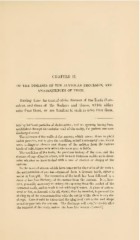Page 215 - My FlipBook
P. 215
CHAPTER II.
OF THE DISEASES OF THE ALVEOLAR PROCESSES, AND
CONSEQUENCES OF THEM.
Having thus far treated of the diseases of the Teeth them-
selves, and those of the Sockets and Gums, which either
arise from them, or are familiar to such as arise from them,
taining brilliant particles of cholesterine ; and an opening having been
established through the anterior wall of the cavity, the patient was soon
discharged cured.
The thinness of the walls of the antrum, which causes them to yield
under pressure, and to give the crackling sound above-mentioned, would
serve to diagnose abscess and dropsy of the antrum from the various
kinds of solid tumours to which the same part is liable.
The condition of the teeth, the previous history of the case, and the
absence of any offensive odour, will in most instances enable us to deter-
mine whether we have to deal with a case of abscess or dropsy of the
antrum.
In the cases of abscess which have come under the notice of the writer,
the accumulation of pus has originated from a diseased tooth, either a
molar or bicuspid. The extraction of the tooth has been followed by a
more or less free discharge of the matter from the antrum. It is, how-
ever, generally necessary to enlarge the opening from the socket of the
extracted tooth, and to wash it out with tepid water. A piece of cotton-
wool or bint, moistened with oil, should then be inserted, to prevent the
closing up of the communication with the cavity while there is any dis-
charge. Care should be taken that the plug is of such a size and shape
as not to pass into the antrum. The discharge will usually subside after
the removal of the tooth, unless the bone has become diseased.]


